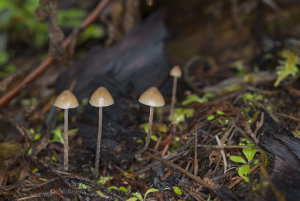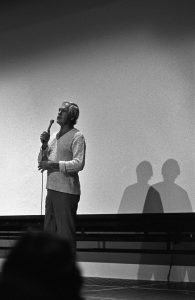7 The History of Psilocybin Mushrooms
Cooper Nicholson
Introduction to Magic Mushrooms
Psilocybe (sai·low·sibe) mushrooms, also known as “magic mushrooms” or “shrooms,” are hallucinogenic drugs that contain the drug psilocybin.

They became popular in the United States during the 1960s when American researchers first studied their healing properties and medical applications. Now, they are listed as a Schedule I controlled substance by the U.S. government, meaning they have no accepted medical use (Houghton, 2021). Despite research that suggests magic mushrooms may be able to treat certain health conditions, many people still believe myths tracing back to the War on Drugs era. This chapter will discuss the history and applications of magic mushrooms.
Chemistry of Magic Mushrooms
The effects of magic mushrooms begin around 30 minutes after they are consumed (Jo et al., 2014). The psilocybin in magic mushrooms activates serotonin receptors in the brain, impacting a person’s mood, perception, and ability to think clearly (Sellers & Davis, 2021). Many factors determine what type of experience someone has after consuming magic mushrooms. The amount a person consumes, their life experiences, and their expectations all play a role in psilocybin effects. This is due to the relationship that psilocybin has with brain receptors. Users should be aware that the strength of psilocybin is almost ten times higher when the mushrooms have been dried. Because the effect of magic mushrooms varies from person to person, it is possible to experience anything from spiritual awakening to frightening hallucinations. For people with mental health disorders, magic mushrooms may increase their risk for a bad experience (Sellers & Davis, 2021). Some people who take magic mushrooms may experience fear, confusion, and psychosis. Symptoms often wear off within 6-8 hours after the body processes the psilocybin. Due to the chemical nature of psilocybin, magic mushrooms are not believed to be addictive (Sellers & Davis, 2021). Regular use of magic mushrooms can cause a person to become tolerant of its effects. Many uses for psilocybin have yet to be discovered. However, magic mushrooms have a complicated history with the U.S. that traces back to the early 1960s.
America’s Introduction to Magic Mushrooms
Timothy Leary and Richard Alpert can be credited for introducing magic mushrooms to popular culture in the United States. Leary, a Psychology Professor at Harvard, became interested in magic mushrooms after reading a Life magazine article about R. Gordon Wasson’s experience with them during a trip to Southern Mexico. Wasson was a banker who participated in a magic mushroom ceremony that positively affected his state of consciousness (Houghton, 2021). Leary began testing the effects of psilocybin by consuming them himself and with others in his labs. During the Concord Prison Experiment, Leary gave inmates psilocybin to determine if hallucinogenic drugs could prevent them from becoming repeat offenders once released. The results from the study found that magic mushrooms decreased the likelihood of a prisoner returning to jail, but questionable research tactics discredited Leary’s work. Despite this, his studies found that psilocybin could positively affect mental health (Houghton, 2021). This led to Leary’s role as an advocate for the benefits of magic mushrooms on the mind and body.

Political Implications
Once word of Leary’s study reached the general public, magic mushrooms gained nationwide attention from musicians and celebrities. The likes of Bob Dylan and John Lennon visited Mexico in search of the psychedelic drug. In 1965, the “hippie movement” popularized the power of magic mushrooms. This movement, partly led by Leary, was advised to “turn on, tune in, and drop out” during a gathering of nearly 30,000 people in San Francisco. This newly adopted lifestyle threatened the traditional understanding of society in America. To counter this, President Richard Nixon began the War on Drugs, a program designed to counteract the effects of the hippie movement and decrease the rates of drug use and overdoses in the country (MAPS, 2016). Nixon followed up this campaign by declaring Leary the “most dangerous man in America” due to his widespread endorsement of hallucinogenic drugs (Houghton, 2021). The War on Drugs led to the classification of psilocybin mushrooms as a Schedule I substance, thus ending all research on the drug. The campaign targeted magic mushrooms by claiming they were highly addictive and destructive to the brain. However, researchers have long since disproven these claims. By making magic mushrooms illegal, Nixon created the belief that psychedelics were dangerous, and he halted any research on these types of drugs until 1992 (MAPS, 2016).
Modern Day Use
Today, the use of magic mushrooms is becoming prevalent again. In 2022, Colorado joined Oregon as the only states to legalize the use of psilocybin mushrooms (Brown, 2022). In the late 20th century, institutions such as Johns Hopkins have begun research on the medical applications of psilocybin. In the year 2000, Rolland Griffiths and Johns Hopkins researchers were the first to receive approval from the United States to continue research on psilocybin mushrooms (Ercolano, 2022). Studies are now evaluating the use of psilocybin as a treatment option to help patients diagnosed with substance abuse, anxiety, depression, and other mental health conditions. As the U.S. begins to tackle the stigma surrounding magic mushrooms, more research can be performed on the regenerative properties of magic mushrooms.
Conclusion
Magic mushrooms have had a complex relationship with the United States, and their users continue to experience judgment from older generations. However, with groundbreaking research on the possible benefits of psilocybin, magic mushrooms may continue to become legalized across the country. Medical prescription of psilocybin may not be in the foreseeable future, but the prospect of psychedelics as a treatment option for patients who have a mental illness is exciting, nonetheless.
Review Questions
1. Who was the Harvard professor that helped introduce magic mushrooms to popular culture in the United States?
a. Richard Alpert
b. R. Gordon Wasson
c. Timothy Leary
d. Rolland Griffiths
2. When ingested, psilocybin mushrooms activate _____ receptors in the brain, impacting a person’s mood, perception, and ability to think clearly.
a. Dopamine
b. Serotonin
c. Acetylcholine
d. Norepinephrine
3. Psilocybin mushrooms have NOT been tested as a treatment option for which of the following illnesses?
a. Substance Abuse
b. Alzheimer’s Disease
c. Depression
d. Anxiety
References
Brown, J. (2022, November 10). Colorado becomes second state to legalize “Magic mushrooms”. The Colorado Sun. https://coloradosun.com/2022/11/09/proposition-122–colorado-results-psilocybin-mushrooms-2/
Ercolano, A. (2023). Psychedelics Research and Psilocybin Therapy. Johns Hopkins Center for Psychedelic and Consciousness Research. https://www.hopkinsmedicine.org/psychiatry/research/psychedelics-research.html
Houghton, S. (2021). From medicine to poison: The magic mushroom in 1960s America. The Collector. https://www.thecollector.com/magic-mushrooms-1960s-america/
Jo, W. S., Hossain, M. A., & Park, S. C. (2014). Toxicological profiles of poisonous, edible, and medicinal mushrooms. Mycobiology, 42(3), 215–220.
https://doi.org/10.5941/MYCO.2014.42.3.215
Johns Hopkins Medicine. (2023). Roland R. Griffiths, Ph.d. https://www.hopkinsmedicine.org/profiles/details/roland-griffiths
Multidisciplinary Association for Psychedelic Studies. (2016). Medical Daily: The war on drugs may have misrepresented psychedelics; here’s why that matters – multidisciplinary association for psychedelic studies. https://maps.org/news/media/medical-daily-the-war-on-drugs-may-have-misrepresented-psychedelics-here-s-why-that-matters/
Sellers, A., & Davis, K. (2021). Psilocybin and magic mushrooms. Medical News Today.
https://www.medicalnewstoday.com/articles/308850
a chemical that can create illusions when consumed
a government program started in 1971 by President Richard Nixon to stop illegal drug use
a chemical in that body that plays a key role in body functions such as mood, sleep, and sexual desire
a type of structure in the brain that responds to chemical messengers
removal of moisture that causes magic mushrooms to shrink and become more concentrated
experiencing something that is not real
a serious mental condition in which a person's connection to reality is lost
the level of awareness an individual has about their own psychological condition and the environment
a follow-up study concluded that the results from the Concord Prison Experiment were misleading due to differences in methodological factors between the study group and control group
a countercultural movement during the 1960s and 1970s that promoted concepts of love and tolerance
causing a strong and harmful need to regularly have to do something
Professor of Psychiatry and Neurosciences at Johns Hopkins School of Medicine that has conducted research on the medical applications of hallucinogenic drugs
to regrow, be renewed, or restored

